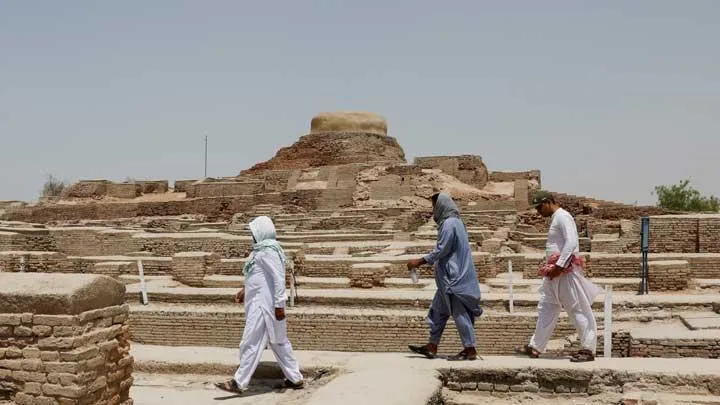The vast expanse of the Thar Desert, stretching across southeastern Pakistan and into the neighboring borders of India, is not merely a barren land of sand dunes and scorching sun. For the people of Pakistan, it’s a symbol of resilience, a canvas of culture, and a testament to the harmony between humanity and harsh nature. Known as the largest desert in Pakistan, the Thar Desert, or Cholistan Desert as it’s called in some areas, spans approximately 200,000 square kilometers. It serves as a home, a livelihood, and a source of inspiration for millions of its inhabitants.
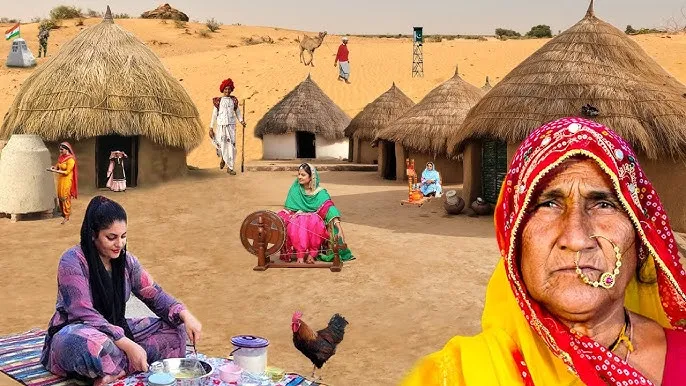
A Land of Contrasts: Geography and Climate
The Thar Desert, with its golden dunes and sparse vegetation, is a region of extremes. Summers in Thar can see temperatures soaring up to 50°C, while winters can be chillingly cold. The monsoon season brings life to this arid land, transforming its terrain into patches of green, though rainfall is scarce and inconsistent.
The desert’s unique geography consists of:
- Sand dunes: Shifting sands shaped by the winds.
- Salt flats: Remnants of dried-up water bodies.
- Oases: Rare spots of greenery where underground water surfaces.
- Seasonal lakes: Filling up during monsoons and vanishing in summers.
The Thar Desert, although harsh and unforgiving, is a land of remarkable resilience. Its geography is not just a challenge but also a canvas for stories of survival and innovation.
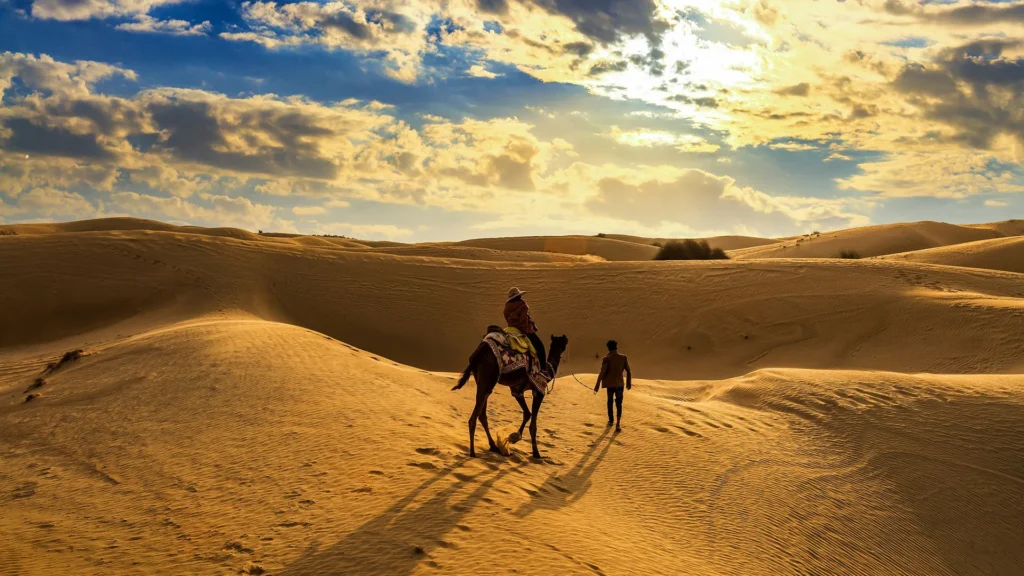
The People of Thar: A Story of Survival and Community
Despite the harsh conditions, over 1.5 million people call the Thar Desert their home. The majority of the population belongs to Sindhi and Rajasthani ethnic groups, practicing centuries-old traditions that reflect their adaptability and deep connection to the land.
Livelihoods in the Desert
The people of Thar have crafted ingenious ways to sustain their lives in this challenging environment:
- Agriculture: People rely on rain-fed farming, growing crops like millet, sorghum, and wheat. With limited rainfall, every drop is utilized wisely through traditional water-conservation methods such as building small dams and reservoirs.
- Livestock rearing: Goats, sheep, and camels form the backbone of their economy. These animals are not only a source of food and income but also integral to cultural practices.
- Handicrafts: Vibrant embroidery, weaving, and pottery are not just sources of income but a celebration of their artistic heritage. These crafts often depict the desert’s flora and fauna, showcasing the deep connection of the people to their environment.
Resilience Through Unity
Thari communities thrive on collective effort. Social gatherings, festivals, and shared responsibilities in tasks like water collection bind the community together. Women, in particular, play a crucial role, managing households, creating crafts, and even contributing to farming and livestock rearing.
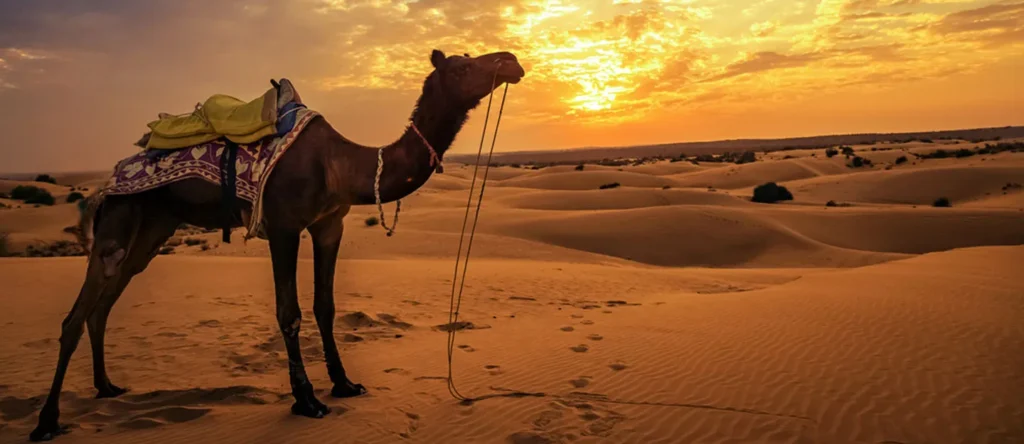
Challenges Faced by the Thari People
Life in the Thar Desert is a constant struggle against nature’s adversities. The challenges are vast and multifaceted:
- Water Scarcity: With no perennial rivers, access to clean drinking water remains a daunting task. Women often walk miles to fetch water, spending hours each day on this exhausting chore.
- Health Issues: Malnutrition and waterborne diseases are rampant, especially among children. Poor medical facilities exacerbate these problems.
- Education: Lack of infrastructure means many children, especially girls, are deprived of schooling. Schools are often far away, and the absence of transportation discourages attendance.
- Climate Change: Unpredictable rainfall patterns exacerbate the hardships of agriculture and livestock farming. Rising temperatures and desertification further threaten the already fragile ecosystem.
Cultural Richness Amidst Adversity
The Thar Desert is not just a geographical entity; it’s a cultural mosaic. The people of Thar express their joys, sorrows, and spiritual beliefs through:
- Music and Dance: Folk songs like “Bhittai’s Kafi” and traditional dances tell tales of love, bravery, and devotion. The tunes of the desert’s unique musical instruments, such as the boreendo and ektara, create a mesmerizing symphony.
- Festivals: Events like the Thar Desert Festival bring communities together to celebrate their heritage. These festivals showcase camel races, traditional games, and the exquisite craftsmanship of the local people.
- Cuisine: Simple yet flavorful dishes like bajra roti, camel milk, and goat curry reflect the resourcefulness of its people. Seasonal fruits like ber and kair are savored as special treats.
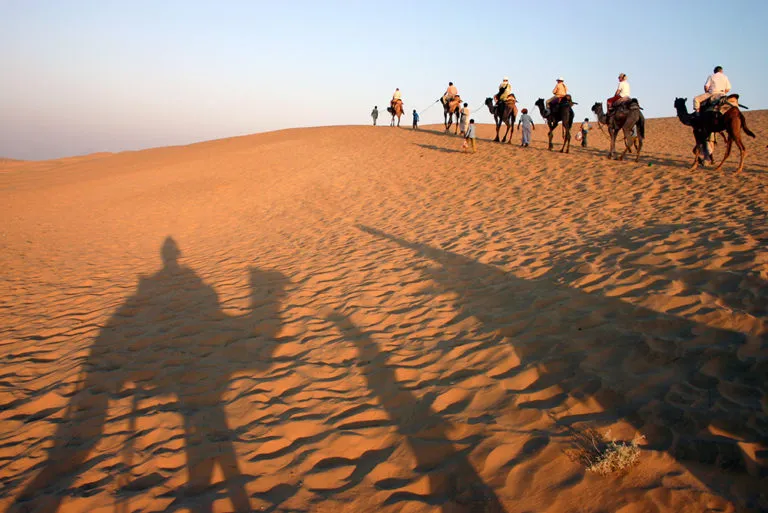
Thar Desert’s Natural Treasures
Despite its aridity, the Thar Desert boasts remarkable biodiversity. This ecosystem is a delicate balance, supporting:
- Flora: Xerophytes like khejri trees, cacti, and shrubs dot the landscape. These plants are vital for both the people and animals of Thar, providing food, fuel, and shade.
- Fauna: Home to species like the Indian gazelle (chinkara), desert fox, and even the elusive caracal. These animals have adapted to survive in extreme conditions, showcasing nature’s ingenuity.
- Birdlife: Seasonal wetlands attract migratory birds like flamingos, cranes, and pelicans, making the Thar Desert a paradise for bird watchers. These birds are a source of awe and a reminder of the interconnectedness of ecosystems.
The desert is also a storehouse of valuable minerals and fossil fuels, including coal reserves that have the potential to contribute significantly to Pakistan’s energy needs.
Government and NGO Efforts
Various initiatives aim to uplift the Thari communities and address their pressing issues:
- Water Projects: Installation of solar-powered RO plants and the creation of artificial reservoirs to provide clean drinking water.
- Education Drives: Mobile schools, community learning centers, and initiatives to encourage female education are making gradual progress.
- Healthcare Camps: Regular medical check-ups, vaccination programs, and mobile health units are improving healthcare access.
- Thar Coal Project: While controversial due to environmental concerns, it aims to boost energy production and create employment opportunities for locals.
NGOs play a vital role, addressing immediate needs such as food and water while advocating for long-term solutions like sustainable agriculture and women’s empowerment.
FAQs About the Thar Desert
1. Why is the Thar Desert significant to Pakistan?
The Thar Desert is Pakistan’s largest desert and a crucial part of its cultural and ecological landscape. It supports diverse flora, fauna, and a resilient human population while holding potential for energy and mineral resources.
2. What are the main problems faced by Thar’s inhabitants?
Water scarcity, health issues, poor infrastructure, and climate change are the primary challenges. These problems require both immediate and long-term solutions.
3. Is the Thar Desert a tourist destination?
Yes, the Thar Desert offers unique experiences like camel safaris, traditional music and dance performances, and bird watching. The annual Thar Desert Festival also attracts visitors from across the globe.
4. What are the government’s efforts for the Thar Desert?
Projects like the Thar Coal Project, renewable energy initiatives, and improved water and healthcare facilities aim to boost the region’s development while addressing local challenges.
5. How can individuals help the people of Thar?
Supporting NGOs working in the region, raising awareness about their challenges, and advocating for sustainable development are some ways to contribute.
Conclusion
The Thar Desert, with its timeless beauty and enduring challenges, is a land of inspiration and resilience. For the people of Pakistan, it represents the strength to thrive against all odds and the richness of cultural and natural heritage. As we look towards the future, it’s imperative to address the pressing issues of water scarcity, education, and climate change to ensure that the Thar Desert continues to flourish as a symbol of hope and perseverance.
The desert’s story is not just about its challenges but also about the incredible spirit of its people. Their ability to find joy, create art, and build a community in one of the harshest environments on Earth is a lesson in resilience and hope for all of humanity.

